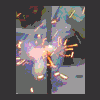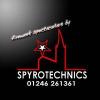Firing system characteristics
#1

Posted 15 April 2009 - 06:13 PM
Here is a quick overview of what I am doing, but if you don't understand all of don't worry, all I need is the on time and the output voltage (or voltage and frequency if its an AC system):
The slave module works by monitoring a trigger line, which can be from any firing system they are using at the time. When that trigger line is activated, it then fires all its cues in a predetermined sequence. It has its own internal 24V rechargeable battery, and 16 cues.
I am at the stage of designing the input circuit, at the moment I have seen voltages ranging from 12V to 24V, but I heard that some systems have an AC output. I have a bridge rectifier, capacitor, resistor and 4V7 zener diode arrangement at the moment, so that the input is compatible with a 5V microcontroller input.
I had in mind checking the input 4 times at 0, 10, 20 and finally 30 milliseconds to confirm it hadnt read spurious input data, before it starts the sequence, but if I find out that a system on the market fires in a shorter time than 30ms, I will have to adjust my software.
So far I can confirm my module is compatible with pyromate, but I wanted to future proof it as they are thinking of buying a new system all together.
My questions are:
What is the lowest duration anyone has seen from a firing system?
What voltage and frequency do AC systems use, and what voltage do capacitor discharge systems use?
Thanks for any replies I get,
Paul
#2

Posted 15 April 2009 - 07:02 PM
Start with an igniter, Commercial ig has a resistance of 1.5 ohms and takes 20ma without firing as a test current, Then forcing a current to flow 500ma will fire all igs of that type.
It's normal to use 12v or up to 48v as 50v is the limit for "Low Voltage" kit. However some CD units fire off 18v and the highest voltage I know is about 800 Now 800VDC is really scary!
A commercial igniter with a good current available will fire in 20msec. You need to make some reasoned assumptions about the length and resistance of the firing cables to determine how many volts you must supply to cause a current of 1 amp to flow through a series array of how many igs.
If you intend to use diy igniters then all the figures change again.
Keep mannequins and watermelons away from fireworks..they always get hurt..
#3

Posted 15 April 2009 - 07:24 PM
Have you seen the capacitive discharge system by pyromate? Are you working towards having this within a 16 cue slave also??? That could be very usefull.
Keep up the hard work, sorry i can`t add anything technical.
#4

Posted 15 April 2009 - 07:29 PM
Some do use AC coupling to the output stage (via cap or transformer), which means the microprocessor sends a burst signal to trigger the output stage. This means that any faults that cause a 'DC lockup' (like a component failure or the processor going into a loop) will not cause accidental firing of the output stages...
 thegreenman
thegreenman
#5

Posted 15 April 2009 - 08:34 PM
Other than that one brand, all controllers seem to be 24v DC Which polarity I don't know! So a small bridge rectifier in the line copes with AC firing and DC either wire positive! In the cold and dark and damp (November!) anything that simplifies field wiring is a help.
Keep mannequins and watermelons away from fireworks..they always get hurt..
#6

Posted 15 April 2009 - 11:00 PM
There are no fixed answers, NONE AT ALL!
Yes, the more I look into it the more I realise there are quite a large range of systems available that use different voltages. I could make it suitable for up to around 30V using the components I have in mind and have priced up. Here is the circuit diagram I have in mind so far, though note that component values may be tweaked when I build the prototype.

The bridge rectifier is comprised of 2 x dual schottky diodes in an SOT23 package. The rest of the parts will all be standard SMD parts too.
I'd heard about the AC coupling before and assumed that was to drive it directly, nice to know its just to drive the output stage, thanks Phil. Think I will still be leaving the bridge rectifier stage in there to protect against reverse polarity though.
Are the high voltage systems specific to things like military and demolition then? I haven't come across them, but if it turns out they are used regularly this firing module is going to be so much more complicated...
Thanks for everyones help so far, didn't expect such fast responses!
#7

Posted 16 April 2009 - 10:08 AM
As you've probably spotted, your input needs to be mostly current rather than voltage sensitive. A 10mA continuity test might only put a volt or so at the output of your circuit but it might be enough to cause trouble
One approach might be to use a relay as the input - you could probably find a fairly hefty one (automotive?) that wouldn't close at 10mA coil current but would at a few hundred mA and could be made compatible with a reasonable range of input voltages and pulses. This would also electrically isolate your sequencer from the main system.
Edited by BrightStar, 16 April 2009 - 01:15 PM.
#8

Posted 16 April 2009 - 06:11 PM
IF you use a cue to trigger a sequencer then you may not have full continuity checking of all the sequencer cues from the firing system.
Keep mannequins and watermelons away from fireworks..they always get hurt..
#9

Posted 16 April 2009 - 07:41 PM
I happened to be looking at the specs for FireOne's new 2-wire firing system
do you mean the existing 2 wire system or is there a newer one on the horizon??
#10

Posted 16 April 2009 - 08:17 PM
So far the firing modes are:
Single trigger, fires all 16 cues with a user configurable delay of 0.1-1 second.
Pulsed trigger, fires one cue per trigger input.
Main system controlled firing, acting as a pyromate module using the VGA type connector.
I'd never thought about using a relay, thats not a bad idea as I have access to hundreds of automotive relays for free from work from obsolete products.
#11

Posted 17 April 2009 - 07:01 AM
Bouncing can cause unplanned firing
Driving relays off a pic needs banks of driver chips which are not needed when you drive a fet. There are some current limiting FETs that protect themselves against over current with an internal kelvin probe.
Keep mannequins and watermelons away from fireworks..they always get hurt..
#12

Posted 17 April 2009 - 12:13 PM
Edited by pyrotrev, 17 April 2009 - 12:19 PM.
#13

Posted 10 June 2009 - 08:07 PM
I made a cd unit from a throw away camera it puts out 330v may fry your picaxe.
the standard circuit for a sloppy signal is something like a 4k7 resistor a 3u3 tantilum capacitor feeding a smitt trigger gate.
Steve.
Thanks for any replies I get,
Paul
[/quote]
#14

Posted 11 June 2009 - 04:18 PM
#15

Posted 13 June 2009 - 08:34 PM

My circuit for a cue interface is very simple just 4 components plus a safety switch.
SW1 connects the input to common ( ground ). It is in the closed Safe position until you are just ready to fire.
R1 is 4k7 and limits the current.
R2 with R1 forms a voltage divider, for 6 volts 10k. and for 48v 470R.
D1 protects against negative input.
C1 is 100nF polycarbonate. In case some idiot uses a mobile next to your wires.
Notes:a twisted pair is best for the wires. also depending on you micro controller you may need a Ls TTL Shottky gate.
I will make another post on how to make an 8 cue sequencer with just two chips.
1 user(s) are reading this topic
0 members, 1 guests, 0 anonymous users
















